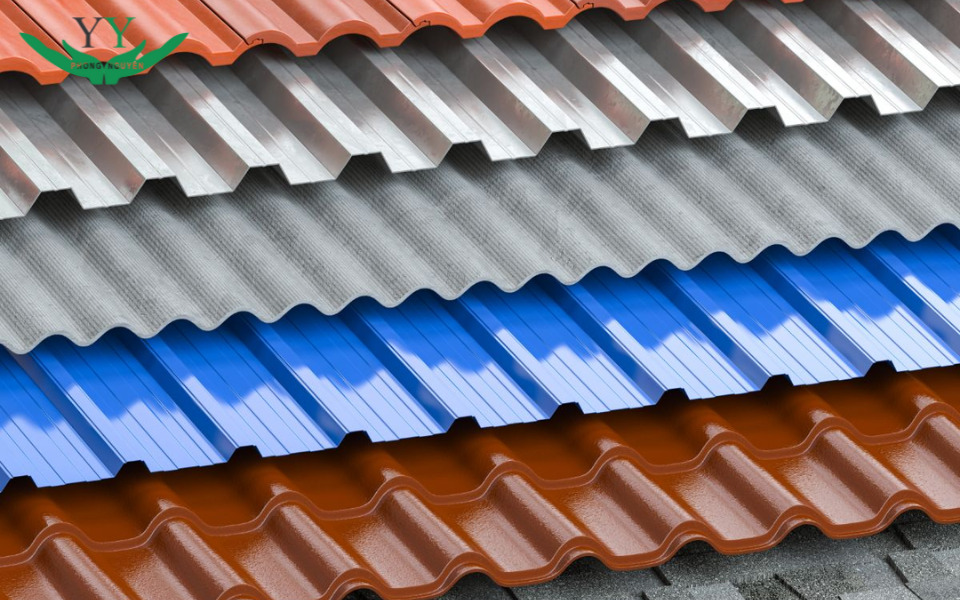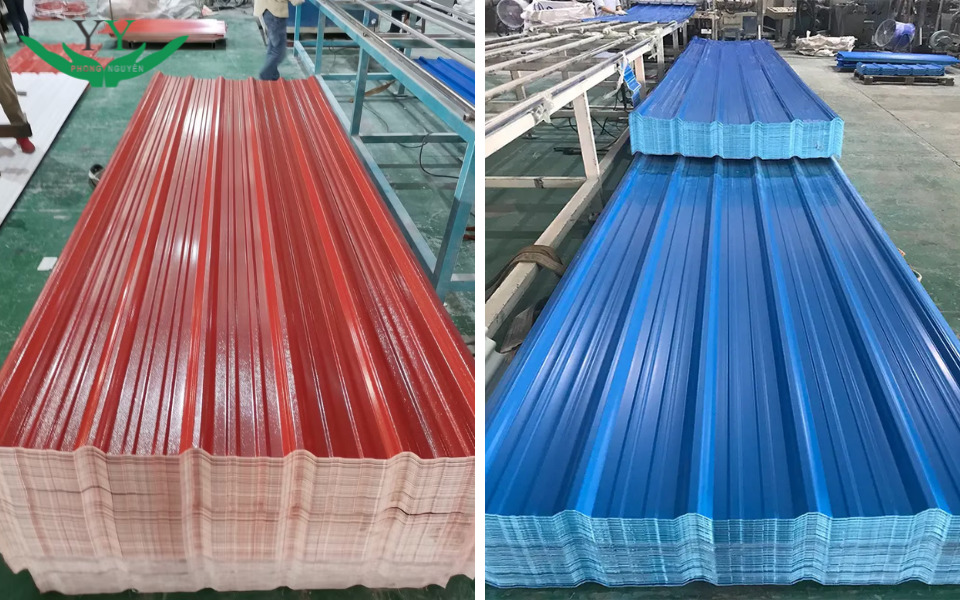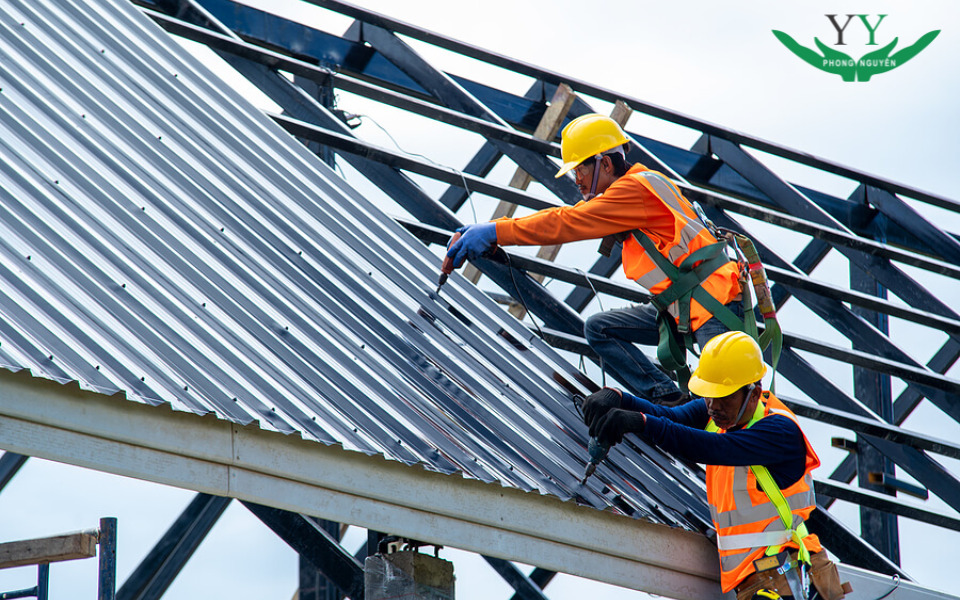In the context of climate change, summer temperatures in Vietnam have been continuously rising each year. Among the various heat protection solutions available today, plastic heat-resistant roofing sheets have emerged as an effective and increasingly popular choice. The following article by Phong Nguyen will help you understand in detail about plastic roofing sheets and their applications.
What is plastic heat-resistant roofing sheet?
Plastic heat-resistant roofing sheet is a type of roofing material made from PVC or ASA plastic, specially designed to minimize the absorption of heat from sunlight, helping to cool the space beneath the roof.

Plastic heat-resistant roofing sheet has excellent thermal insulation capabilities, helping to reduce the temperature inside buildings compared to the outside temperature, making it especially suitable for Vietnam’s hot and humid climate. This type of roofing is commonly used to replace metal roofing in residential buildings, factories, warehouses, farms, and many other structures to reduce the impact of high external temperatures.
Structure of plastic heat-resistant roofing sheet
Plastic heat-resistant roofing is made from multiple layers of different materials, each with specific functions and characteristics, helping to optimize the insulation, heat resistance, and durability of the product. The structure of plastic heat-resistant roofing sheet typically includes the following main layers:
- Surface layer (UV protection layer): This is the outermost layer of the plastic roofing, often coated with a special plastic or UV-resistant paint, helping to protect the roofing from degradation and fading due to sunlight. Additionally, this layer also protects the inner layers from corrosion and damage.
- Main plastic layer (Polycarbonate or PVC): Made from synthetic plastics like polycarbonate (PC) or PVC, this layer helps minimize the transmission of heat from the outside into the building.
- Insulation layer (Polyurethane or fiberglass): Some plastic heat-resistant roofing sheets include an insulation layer between the main plastic layer and the outer protective layer. This layer is often made of materials like polyurethane (PU) or fiberglass, helping to prevent the temperature from rising due to sunlight exposure.
- Bottom layer or noise-dampening layer: Some high-end plastic heat-resistant roofing products feature a cushion at the bottom to reduce noise from external environments. This layer is often made from foam materials or flexible materials with noise-reducing and vibration-absorbing properties.
Advantages of plastic heat-resistant roofing sheet
In the face of increasingly hot climates, seeking construction solutions that reduce temperature and save energy has become an important factor. So, what are the outstanding advantages of plastic heat-resistant roofing sheet?
Excellent insulation
Plastic heat-resistant roofing sheet has superior insulation compared to traditional metal roofing sheets. Thanks to its multi-layer structure and insulation materials like polyurethane (PU) or fiberglass, plastic roofing helps minimize heat transfer from the outside into the building. This is particularly useful in hot regions, maintaining a cooler environment inside buildings.

UV protection
Plastic heat-resistant roofing is often coated with a UV protection layer, which prevents the harmful effects of ultraviolet (UV) rays from the sun. This not only protects the roofing from damage and fading, thus saving on maintenance or replacement costs throughout its usage.
Lightweight and easy to install
Compared to heavy metal roofing sheets, plastic heat-resistant roofing sheet is lighter, which reduces pressure on the roof structure and makes transportation and installation easier. This not only saves costs but also speeds up the construction process, reducing the time and effort needed.
Waterproof
Plastic heat-resistant roofing has excellent waterproofing capabilities, protecting buildings from rainwater infiltration. Quality plastic roofing is designed to prevent leaks, avoiding moisture, mold, and other humidity-related damages, thereby maintaining a dry and safe environment for users.
Impact resistance
Plastic heat-resistant roofing has high mechanical strength and can withstand strong impacts without easily breaking. This feature is especially important for structures such as factories, warehouses, or areas prone to mechanical accidents. Additionally, its ability to withstand harsh weather conditions, such as heavy rain and strong winds, is another significant advantage of plastic roofing.
Applications of plastic heat-resistant roofing sheet
Roofing materials like plastic heat-resistant tiles and plastic roofing sheets are increasingly favored for their insulation capabilities. Thanks to this advantage, they are highly suitable for use in hot regions like Vietnam and are gaining popularity. Some applications of plastic heat-resistant roofing include:
Roofing for residential buildings
Plastic heat-resistant roofing is commonly used in residential buildings, villas, garden houses, and resorts. With its effective insulation ability, plastic roofing helps reduce the internal temperature of the house, creating a cooler and more comfortable space, especially in the hot summer months.

Roofing for factories and warehouses
Factories, warehouses, and industrial buildings also favor plastic heat-resistant roofing sheet due to its insulation and noise-dampening capabilities. Using plastic roofing in these buildings helps maintain a stable temperature inside while reducing noise from rainfall, thereby protecting products and creating a comfortable working environment for employees.
Roofing for livestock farms
Plastic heat-resistant roofing is widely used for roofing on farms and animal husbandry facilities. Maintaining an optimal temperature in these areas is essential to ensure ideal living conditions for animals and crops. Plastic roofing not only helps lower the temperature but also provides protection from rain and wind, maintaining a stable environment for livestock.

Roofing for outdoor sports facilities
Plastic heat-resistant roofing is also used for roofing on outdoor sports facilities such as tennis courts, football fields, basketball courts, and stadiums. Thanks to its UV protection and insulation properties, this type of roofing helps protect participants from direct sunlight while keeping the interior space cool and ventilated.
Conclusion
Plastic heat-resistant roofing sheet is an effective solution to improve living and working environments in hot climates. Its outstanding advantages, such as waterproofing, lightweight, durability, and aesthetics, have made it an ideal choice for many projects, from residential to industrial.
Phong Nguyen is one of the leading manufacturers of high-quality plastic heat-resistant roofing in Vietnam. Made from ASA-PVC plastic with a 4-layer structure, Phong Nguyên plastic roofing boasts superior durability and resistance to corrosion, water infiltration, fire, as well as insulation and soundproofing capabilities. Phong Nguyên plastic roofing is confidently the ideal choice for all construction projects. Contact us now for a detailed quote!

